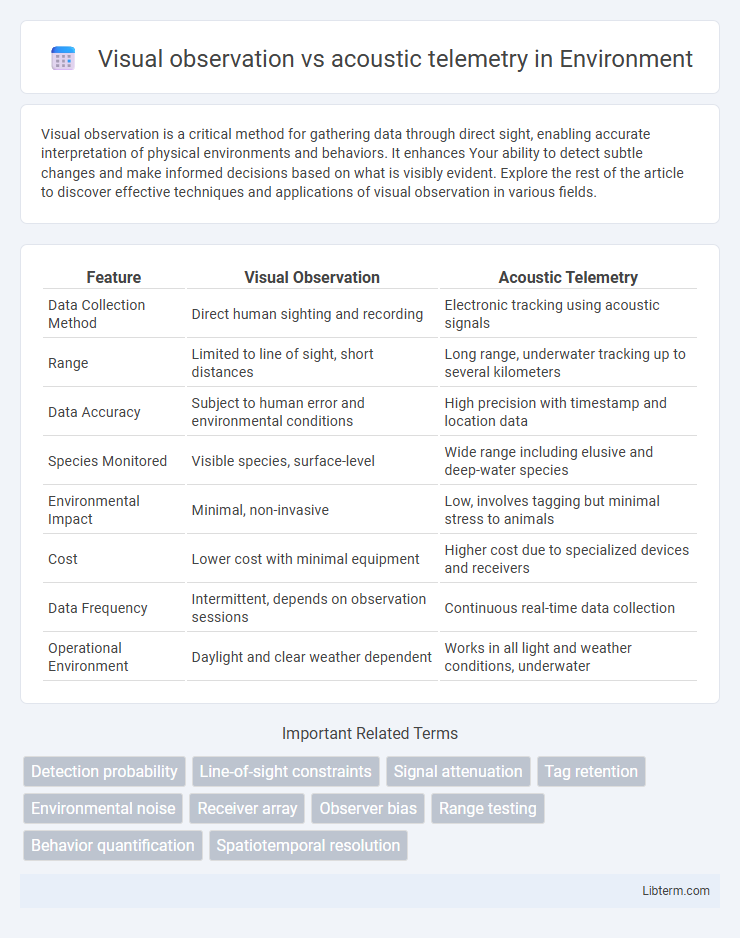Visual observation is a critical method for gathering data through direct sight, enabling accurate interpretation of physical environments and behaviors. It enhances Your ability to detect subtle changes and make informed decisions based on what is visibly evident. Explore the rest of the article to discover effective techniques and applications of visual observation in various fields.
Table of Comparison
| Feature | Visual Observation | Acoustic Telemetry |
|---|---|---|
| Data Collection Method | Direct human sighting and recording | Electronic tracking using acoustic signals |
| Range | Limited to line of sight, short distances | Long range, underwater tracking up to several kilometers |
| Data Accuracy | Subject to human error and environmental conditions | High precision with timestamp and location data |
| Species Monitored | Visible species, surface-level | Wide range including elusive and deep-water species |
| Environmental Impact | Minimal, non-invasive | Low, involves tagging but minimal stress to animals |
| Cost | Lower cost with minimal equipment | Higher cost due to specialized devices and receivers |
| Data Frequency | Intermittent, depends on observation sessions | Continuous real-time data collection |
| Operational Environment | Daylight and clear weather dependent | Works in all light and weather conditions, underwater |
Introduction to Fish Monitoring Methods
Visual observation and acoustic telemetry represent two key fish monitoring methods with distinct advantages and applications. Visual observation allows direct assessment of fish behavior and habitat use through snorkeling, diving, or underwater cameras, providing real-time qualitative data. Acoustic telemetry employs tagged fish and underwater receivers to track movement patterns over larger spatial and temporal scales, delivering precise quantitative insights into migration and population dynamics.
Overview of Visual Observation Techniques
Visual observation techniques encompass direct methods such as snorkeling, scuba diving, and surface observation from boats or shorelines to monitor aquatic species and behaviors. These methods rely on human sight to identify, count, and track organisms, providing immediate data on habitat use, species interactions, and environmental conditions. While limited by water clarity, light availability, and observer presence, visual observation offers valuable real-time insights without the need for electronic devices or tagging.
Fundamentals of Acoustic Telemetry
Acoustic telemetry uses ultrasonic transmitters and underwater receivers to track aquatic animals by detecting sound pulses over distances up to several kilometers, allowing continuous data collection in various aquatic environments. Visual observation relies on direct sighting, which is limited by water clarity, light conditions, and observer presence, making acoustic telemetry more reliable for long-term and large-scale monitoring. Fundamental to acoustic telemetry is signal propagation, involving sound frequency selection to minimize attenuation and maximize detection range, alongside receiver array placement to triangulate animal positions accurately.
Data Precision and Accuracy Comparison
Visual observation provides direct, real-time data with high spatial accuracy but is often limited by observer bias and environmental conditions, reducing overall data precision. Acoustic telemetry offers continuous monitoring with precise location tracking using ultrasonic signals, enhancing data accuracy in detecting animal movements over large, obscured areas. Combining both methods optimizes data reliability by balancing the detailed behavioral insights from visual observation with the robust spatial-temporal resolution of acoustic telemetry.
Temporal and Spatial Coverage Considerations
Visual observation provides limited temporal coverage as it relies on direct human presence, often restricting data collection to daylight hours and favorable weather conditions. Acoustic telemetry enables continuous monitoring over extended periods and broad spatial scales, capturing fine-scale movement patterns and habitat use even in turbid or inaccessible environments. The integration of acoustic telemetry significantly enhances spatial resolution and temporal frequency compared to visual methods, supporting comprehensive ecological studies and effective wildlife management.
Pros and Cons of Visual Observation
Visual observation offers direct and real-time monitoring of aquatic species, enabling detailed behavioral analysis and species identification without the need for complex equipment. However, its effectiveness is limited by poor visibility conditions such as turbidity, low light, and large spatial coverage, which can reduce data accuracy and completeness. Visual methods are also labor-intensive, requiring trained personnel and potentially introducing observer bias, contrasting with the automated data collection provided by acoustic telemetry.
Advantages and Limitations of Acoustic Telemetry
Acoustic telemetry offers precise, long-range tracking of aquatic species regardless of water clarity, enabling continuous data collection in diverse environmental conditions. It overcomes the limitations of visual observation, which is restricted by water turbidity, light availability, and observer presence. However, acoustic telemetry requires initial equipment investment, potential signal interference, and limited spatial resolution compared to direct visual counting.
Cost and Resource Implications
Visual observation requires minimal equipment but often demands extensive human labor, resulting in higher personnel costs and time investment. Acoustic telemetry involves substantial upfront expenses for tagging devices and receiver arrays, yet it offers continuous, automated data collection that reduces long-term labor requirements. Budget considerations must weigh the trade-offs between initial hardware investment and ongoing field personnel costs to optimize resource allocation.
Applications in Fisheries and Aquatic Research
Visual observation provides direct, real-time data on fish behavior, habitat use, and species identification, essential for short-term studies and habitat assessments in fisheries management. Acoustic telemetry enables continuous tracking of individual fish movements over large spatial and temporal scales, offering detailed insights into migration patterns, habitat connectivity, and survival rates in aquatic research. Combining both methods enhances data accuracy and depth, supporting effective conservation strategies and sustainable fisheries practices.
Future Trends in Fish Monitoring Technologies
Future trends in fish monitoring technologies emphasize integration of visual observation with advanced acoustic telemetry to enhance data precision and coverage. Hybrid systems combining high-resolution underwater cameras and real-time acoustic tagging enable detailed behavioral analysis and species tracking in diverse aquatic environments. Machine learning algorithms applied to these merged datasets optimize species identification and movement prediction, driving advancements in sustainable fisheries management.
Visual observation Infographic

 libterm.com
libterm.com